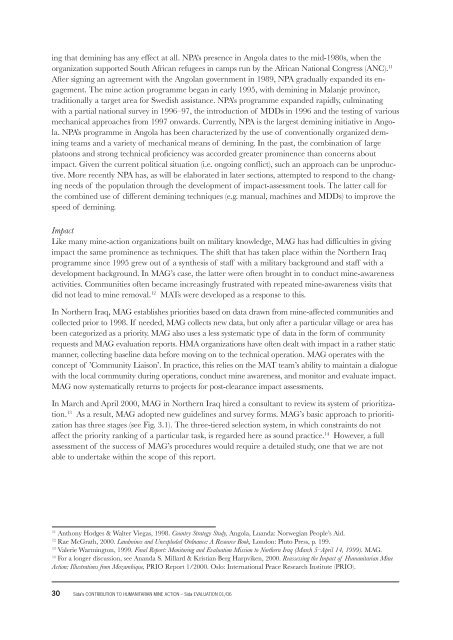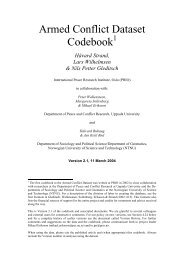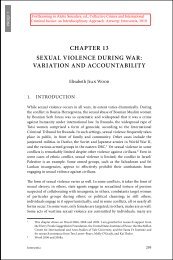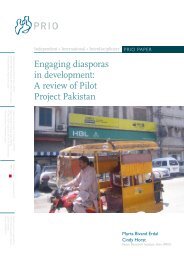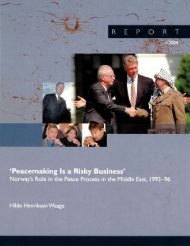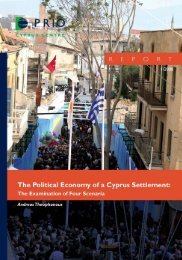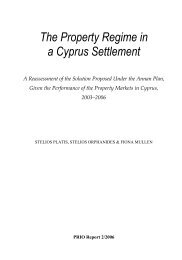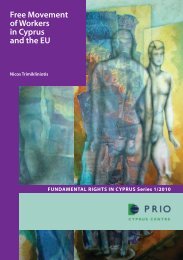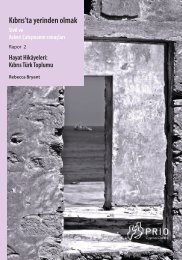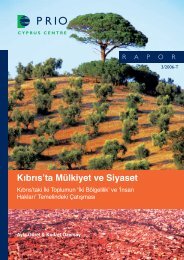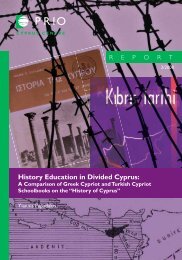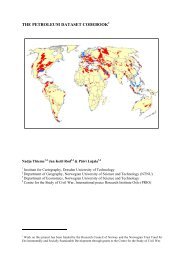ing that demining has any effect at all. NPA’s presence in Angola dates <strong>to</strong> the mid-1980s, when theorganization supported South African refugees in camps run by the African National Congress (ANC). 11After signing an agreement with the Angolan government in 1989, NPA gradually expanded its engagement.The mine action programme began in early 1995, with demining in Malanje province,traditionally a target area for Swedish assistance. NPA’s programme expanded rapidly, culminatingwith a partial national survey in 1996–97, the introduction of MDDs in 1996 and the testing of variousmechanical approaches from 1997 onwards. Currently, NPA is the largest demining initiative in Angola.NPA’s programme in Angola has been characterized by the use of conventionally organized deminingteams and a variety of mechanical means of demining. In the past, the combination of largepla<strong>to</strong>ons and strong technical proficiency was accorded greater prominence than concerns aboutimpact. Given the current political situation (i.e. ongoing conflict), such an approach can be unproductive.More recently NPA has, as will be elaborated in later sections, attempted <strong>to</strong> respond <strong>to</strong> the changingneeds of the population through the development of impact-assessment <strong>to</strong>ols. The latter call forthe combined use of different demining techniques (e.g. manual, machines and MDDs) <strong>to</strong> improve thespeed of demining.ImpactLike many mine-action organizations built on military knowledge, MAG has had difficulties in givingimpact the same prominence as techniques. The shift that has taken place within the Northern Iraqprogramme since 1995 grew out of a synthesis of staff with a military background and staff with adevelopment background. In MAG’s case, the latter were often brought in <strong>to</strong> conduct mine-awarenessactivities. Communities often became increasingly frustrated with repeated mine-awareness visits thatdid not lead <strong>to</strong> mine removal. 12 MATs were developed as a response <strong>to</strong> this.In Northern Iraq, MAG establishes priorities based on data drawn from mine-affected communities andcollected prior <strong>to</strong> 1998. If needed, MAG collects new data, but only after a particular village or area hasbeen categorized as a priority. MAG also uses a less systematic type of data in the form of communityrequests and MAG evaluation reports. HMA organizations have often dealt with impact in a rather staticmanner, collecting baseline data before moving on <strong>to</strong> the technical operation. MAG operates with theconcept of ’Community Liaison’. In practice, this relies on the MAT team’s ability <strong>to</strong> maintain a dialoguewith the local community during operations, conduct mine awareness, and moni<strong>to</strong>r and evaluate impact.MAG now systematically returns <strong>to</strong> projects for post-clearance impact assessments.In March and April 2000, MAG in Northern Iraq hired a consultant <strong>to</strong> review its system of prioritization.13 As a result, MAG adopted new guidelines and survey forms. MAG’s basic approach <strong>to</strong> prioritizationhas three stages (see Fig. 3.1). The three-tiered selection system, in which constraints do notaffect the priority ranking of a particular task, is regarded here as sound practice. 14 However, a fullassessment of the success of MAG’s procedures would require a detailed study, one that we are notable <strong>to</strong> undertake within the scope of this report.11Anthony Hodges & Walter Viegas, 1998. Country Strategy Study, Angola, Luanda: Norwegian People’s Aid.12Rae McGrath, 2000. Landmines and Unexploded Ordnance: A Resource Book, London: Plu<strong>to</strong> Press, p. 199.13Valerie Warming<strong>to</strong>n, 1999. Final Report: Moni<strong>to</strong>ring and Evaluation Mission <strong>to</strong> Northern Iraq (March 5–April 14, 1999). MAG.14For a longer discussion, see Ananda S. Millard & Kristian Berg Harpviken, 2000. Reassessing the Impact of <strong>Humanitarian</strong> <strong>Mine</strong><strong>Action</strong>: Illustrations from Mozambique, PRIO Report 1/2000. Oslo: International Peace Research Institute (PRIO).30 Sida’s CONTRIBUTION TO HUMANITARIAN MINE ACTION – Sida EVALUATION 01/06
First stage Second stage Third stageImpact assessment: thisincorporates accidents,denied access or proximityof minefields <strong>to</strong> roads and/or settlements, the numberof beneficiaries and acommunity’s ownprioritization of minefields. 15Assessment of constraints:metal contamination (natural andfragments), access, securityproblems or community conflictsover land. In the event that thereis a high level of constraint,demining an area is deferred, butits priority ranking remains thesame.Assessment of feasibility:preference is given <strong>to</strong>minefields on the basis of theconfirmed presence of mines(as opposed <strong>to</strong> their onlybeing suspected), not havingbenefited from earlier MAGoperations, or high visibilityof minefields. 16Fig. 3.1. MAG Northern Iraq – three-stage priority-setting approachIn Angola, the number of victims from mine accidents is amongst the world’s highest. The ongoingarmed conflict has forced the migration of large numbers of the population. As a result, assessingimpact is particularly difficult in Angola. Nevertheless, because of the extensive mine problem in thecountry, there is an immediate need for a mine-action programme. NPA Angola is currently in theprocess of attempting <strong>to</strong> operationalize a systematized impact-assessment (IA) methodology. Thismethodology is based on a three-tiered reporting system, which includes taking in<strong>to</strong> account the needsand capacities of communities. It also takes in<strong>to</strong> account the ability of non-HMA implementers <strong>to</strong>support a particular programme and NPA’s capacity <strong>to</strong> conduct an operation. Some operation andproject managers have been trained in the use of these <strong>to</strong>ols. This IA methodology requires thatproject managers report on a monthly basis on impact assessments that are under way and on possiblefuture tasks. The assessment reports are sent <strong>to</strong> the management team, which is ultimately responsiblefor decisionmaking regarding task prioritization. This impact-assessment system will be used on a trialbasis for three <strong>to</strong> four months, and an evaluation and follow-up training will be conducted after theinitial trial period. It is expected that the current methodology will undergo some modification so thatit is better able <strong>to</strong> respond <strong>to</strong> the practical constraints that may be encountered during the trial period.The contextual difficulties in Angola have led <strong>to</strong> numerous problems that may not be considerationselsewhere. Currently, there is considerable debate within NPA as <strong>to</strong> whether a task can be suspended inorder <strong>to</strong> take on another task of higher priority. Key staff in the organization feel this should be possible,but also recognize that shifting between tasks may cause problems since the situation on the groundchanges so often. However, staff-members also believe there should be a level of flexibility so as <strong>to</strong>evaluate the situation as relevant <strong>to</strong> each case. In short, for NPA <strong>to</strong> be able <strong>to</strong> maximize its impact atthe national level, it needs <strong>to</strong> be able <strong>to</strong> shift its operations in accordance with contextual changes onthe ground. For example, the movement of large numbers of population from one province <strong>to</strong> anothermay lead <strong>to</strong> changed priorities. Luena, in Moxico province, has become host <strong>to</strong> thousands of internallydisplaced persons (IDPs) in the last 18 months. As a consequence, mines in the area also pose a greaterthreat due <strong>to</strong> the increase in populations, and their lack of familiarity with where they are located.CoordinationWhen setting up MATs, a driving force for MAG Northern Iraq was the problems it had encounteredin coordinating a mine action response. There were often long delays between an initial survey and the15MAG Northern Iraq, 1999. Prioritisation Process for <strong>Mine</strong> Clearance Operations.16The criteria applied by MAG are relatively simple, as compared for example <strong>to</strong> the SAC system. The emphasis oncommunity priorities is considered fundamental and serves as a check on MAG’s own observations.Sida’s CONTRIBUTION TO HUMANITARIAN MINE ACTION – Sida EVALUATION 01/06 31
- Page 4: This report is part of Sida Evaluat
- Page 9 and 10: MDDMEDDSMGMMLSWMoPHMOUMPLANATONDING
- Page 12 and 13: the conclusions of this report is t
- Page 14 and 15: A prime concern with Mine Action Ce
- Page 16 and 17: 3. The coordination of mine action,
- Page 18 and 19: an needs and the needs of victims o
- Page 20 and 21: At the same time as Sida has been o
- Page 22 and 23: er, throughout the data collection,
- Page 24 and 25: Donors may feel that the costs of i
- Page 26 and 27: is genuinely new. 8 At an overall l
- Page 28 and 29: The first attempt to apply a form o
- Page 30 and 31: standard for basic impact surveys.
- Page 32 and 33: Community studiesCommunity studies
- Page 34 and 35: and progress monitored in all phase
- Page 36 and 37: 3 Implementation ChannelsOver the p
- Page 38 and 39: cal implementation and management,
- Page 42 and 43: actual response. In an effort to ov
- Page 44 and 45: ecently developed. The approaches t
- Page 46 and 47: A different tool that will be used
- Page 48 and 49: Alternative implementation channels
- Page 50 and 51: appear to have been doing a good jo
- Page 52 and 53: Coordination may at times even be c
- Page 54 and 55: itarian and development effort. Imp
- Page 56 and 57: Two). In terms of coordinating mine
- Page 58 and 59: ased demining of AREA. Another type
- Page 60 and 61: The Kosovo UNMACC took a number of
- Page 62 and 63: would be accredited and tasked by U
- Page 64 and 65: programme. The proposal was backed
- Page 66 and 67: The present landscape of Swedish ac
- Page 68 and 69: demining purposes. Buoyed by a wave
- Page 70 and 71: given that SRSA also recruits perso
- Page 72 and 73: teams. The need for a breeding capa
- Page 74 and 75: 6 RecommendationsIn the preceding c
- Page 76 and 77: • MACs should operate with agreem
- Page 78 and 79: 7 ConclusionIn this report, we have
- Page 80: 70Appendix 1
- Page 89 and 90: Ziauddin Operations Officer METADup
- Page 91 and 92:
Bennedich, Claes Department for eva
- Page 93 and 94:
Appendix 3BIBLIOGRAPHYAccelerated D
- Page 95 and 96:
Faulkner, F. & L Pettiford, 1998.
- Page 97 and 98:
McGrath, Rae, 2000. Landmines and U
- Page 99 and 100:
Miscellaneous DocumentsBrady, Justi
- Page 101 and 102:
Appendix 4Sida’s CONTRIBUTION TO
- Page 103 and 104:
Appendix 6• The area must be secu
- Page 105 and 106:
Appendix 7Locality identifier: Dist
- Page 107:
Recent Sida Evaluations00/37:1 Asse


